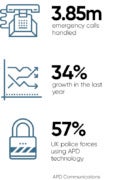 Public sector cuts since the financial crash of 2008 have forced emergency services to hang on to legacy technology to keep costs down. Unable to place big orders on new technology, IT teams have kept old systems functioning and integrated mixed estates.
Public sector cuts since the financial crash of 2008 have forced emergency services to hang on to legacy technology to keep costs down. Unable to place big orders on new technology, IT teams have kept old systems functioning and integrated mixed estates.
Police forces, in particular, have had to manage these technical limitations amid further strains on their services. Police budgets fell by 20 per cent between 2010 and 2015 despite an evolving threat landscape, including in the cyber sphere and a dramatic increase in 101 calls, which now account for up to 70 per cent of calls taken in a control room.
These pressures on emergency services have encouraged police forces to utilise cloud-based control room solutions that are flexible, scalable and, most importantly, don’t require large capital investments. The vision is to create a single, cost-effective and easy-to-manage platform that all UK emergency services use to serve the public.
APD Communications is at the forefront of this vision and innovation. The UK-based software company develops critical control room and fleet technologies that enable emergency services to communicate quicker and more efficiently in 999 situations. Over 57 per cent of UK police forces already use its control room technology and ten forces use its cloud services.

We’ve been creating innovative communications technology for more than 30 years. Two years ago, we started working on removing all proprietary hardware in favour of open-standards software. Then in 2016, we launched our hosted solution in Sweden, a world first, which is now being used to communicate and save lives.
The importance of this was to prepare our technology for the new Emergency Services Network (ESN), a 4G mobile network that the emergency services will use to replace the costly Terrestrial Trunked Analogue Radio (TETRA).
The vision is to create a single, cost-effective and easy-to-manage platform that all UK emergency services use to serve the public
APD has developed its hosted control room solution, a cloud-based data and communications platform that provides a control room with the core technology it needs to serve the public. The company has also innovated with the UK police to create an online portal where the public can web chat with their local force, report crimes and read appointments.
What are the biggest challenges facing emergency services in the UK today?
Our customers are telling us that the biggest issues they are facing are related to the funding available to our emergency services. The Fire Brigades Union, for example, said it has lost 20 per cent of its funding and has 10,000 fewer firefighter jobs since 2010. The police in England and Wales have 18,000 fewer officers since 2010, according to Home Office figures, and budget cuts of up to 20 per cent. The emergency services in the UK deliver brilliant services to the public, but it becomes increasingly difficult for them to maintain those standards with even tighter budgets.
To what extent is technology important in dealing with those challenges?
Technology is a big enabler when it comes to doing more with less. In an increasingly digital world, the emergency services need technology to deliver their service to the public in the most effective way possible. Together they save lives. With fewer people, they have to look for efficiencies in how they operate. Technology can provide those efficiencies, but it has to be cost effective. Cloud computing is at the heart of this, providing organisations with a much smaller and manageable infrastructure footprint, as well as affording them the flexibility to only pay for what they use.
How do you see public sector cuts driving the emergency services to deploy technology in new ways?
Fewer people mean you have to be more efficient, while smaller budgets mean you have to be cost effective. Reducing cost and increasing efficiency can be enabled by technology. This has forced suppliers, such as APD, and the emergency services to rethink the way they work together. Centralising technology in the cloud means access to the latest technology and features, easily flexing up and down with demand, and managing the way you work from a central point. This is instantly more cost effective and efficient for both the supplier and the customer. With 99.99 per cent uptime and with top security accreditations, the adoption has already begun.
Why do you think the cloud is such an important asset to the emergency services during these times of budget restraints?
It is low cost, more secure and scalable, as well as being easier to manage, and they can take advantage of the latest technology quickly. It also connects them to the public in new ways, such as web chat and social media.
How have perceptions towards cloud technologies changed in the emergency services?
People within the emergency services are now using cloud technology in their everyday lives, from Dropbox to iCloud, Siri to Alexa. They are looking at these innovations and wanting to take advantage of the benefits they bring to the workplace. Combine this with public sector cuts and the emergency services are naturally looking to buy and use technology in new ways. As the general public demand a higher level of care and customer services, cloud technologies are no longer seen as a threat to IT departments, but as an enabler.
What’s next for APD?
As a UK-based development company, we will continue to gather new requirements from our customers. We are working closely with the Home Office to produce the latest technology too and we are looking for joint development partners within the emergency services so we can continue to develop world-leading technology.
Delivering a cloud-based service enables us to gather new requirements quickly and deliver them promptly to all the organisations that offer emergency services, without the need for costly site visits or upgrades.
For more information please visit www.apdcomms.com


